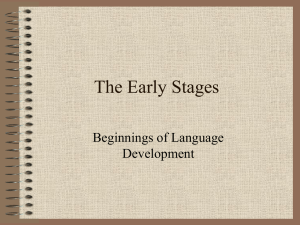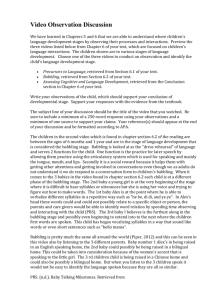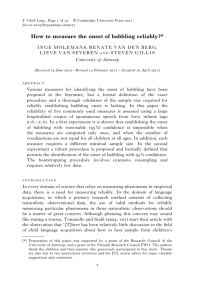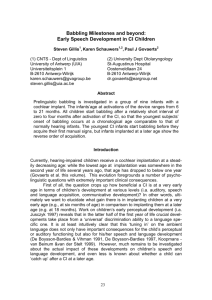phonological development related with cleft palate
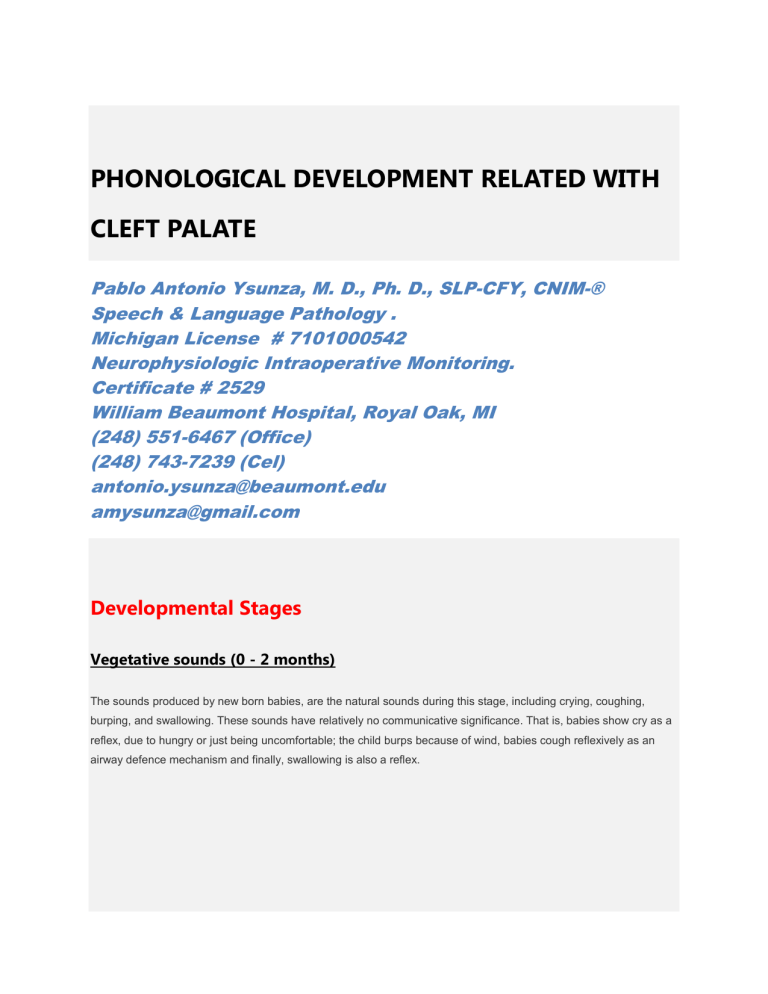
PHONOLOGICAL DEVELOPMENT RELATED WITH
CLEFT PALATE
Pablo Antonio Ysunza, M. D., Ph. D., SLP-CFY, CNIM-®
Speech & Language Pathology .
Michigan License # 7101000542
Neurophysiologic Intraoperative Monitoring.
Certificate # 2529
William Beaumont Hospital, Royal Oak, MI
(248) 551-6467 (Office)
(248) 743-7239 (Cel) antonio.ysunza@beaumont.edu amysunza@gmail.com
Developmental Stages
Vegetative sounds (0 - 2 months)
The sounds produced by new born babies, are the natural sounds during this stage, including crying, coughing, burping, and swallowing. These sounds have relatively no communicative significance. That is, babies show cry as a reflex, due to hungry or just being uncomfortable; the child burps because of wind, babies cough reflexively as an airway defence mechanism and finally, swallowing is also a reflex.
Cooing and laughter (3 - 6 months)
These sounds usually occur when the infant is comfortable and content. They are usually the combination of a vowel and a consonant.
Babbling (7 - 13 months)
non mam peep ooboo ama eewee
This is actually the onset of linguistic development. Parents particularly remember their child during this stage. It should be pointed out that this stage can also be divided in two important components: (1) canonical babbling , and
(2) variegated babbling :
1.
canonical babbling (7 - 10 months)**** a) One type of canonical babbling is reduplicated babbling , in which the child produces a series of
Consonant-Vowel (CV) syllables with the same consonant being repeated. The following are some examples. wa-wa-wa ab-ab-ab mu-mu-mu b) A second type is non-reduplicated babbling . During this sub – stage, infants produce vocalizations either in the form of Consonant-Vowel-Consonant (CVC) sequences or Vowel-Consonant-Vowel combinations.
The following are examples of these forms.
2.
variegated babbling (11 - 12 months)
The sequences of syllables show increasing variation. Diverse babbling emerges. The following are common examples.
Ma – moo - mee ba - doo wo - mee
It should be noted that not every report categorizes phonological development according to the stages described herein.. So much development is happening all at the same time during the critical period of time between 10-12 months, that is has been difficult to efficiently divide the development of speech into evidence based discrete categories.
However, most authors agree that during these developmental stages, the child produces nothing more than a sort of verbal play. Children are practicing individual sounds and sound sequences. They are mastering the motor skills necessary to produce what will eventually become utterances with meaning, that is, words. The appearance of words, mark the onset of linguistic development (one-word stage). Moreover, it has been reported that at the onset of this stage, the phonological rules have usually been established in the Central Nervous System of the child.
One Word Stage (13 - 18 months)
The words used by the child can now be identified as similar to the words used after a complete linguistic development has been achieved. Single words are used for expressing feelings, needs and so on. During this time, children start naming and labelling. The characteristic consonant sounds used during this stage include:
/m/, /n/, /p/, /b/, /t/, /d/, /w/
Two Word Stage (20 - 30 months)
The child now begins to produce twoword combinations such as “baby eats” , “car there”, “where mommy ? “. The following additional consonants are consolidated during this stage:
/k/, /g/, /ng/ (as in sing) h
Sentences and Beyond (32 months +)
Children start using combinations creating real sentences with rudimentary syntax. However, meaning is effectively communicated and speech is intelligible practically for everyone.
During the following years, the child consolidates the use of the remaining English consonants.
2;06 - 3;06 f s y
3;06 - 4;06 v z l sh ch j
4;06 + zh (as in
measure
) th th (as in
the
) r
Consonant sounds are generally acquired in a front-to-back pattern so that sounds made at the front of the mouth such as ‘m’, ‘p’, ‘b’ and ‘w’ (1;06-2;00 years) will develop and be used by the child before sounds made at the back of the mouth, such as ‘k’, ‘g’, ‘ng’ and ‘h’ (2;00-2;06 years).
Of course, it should be considered that there are exceptions to every rule. Generally, whilst one would expect a child to use the front sound ‘p’ before the back sound ‘k’ there will always be the child who does it the other way around.
Plosive phonemes are produced by a complete obstruction of the pulses of airflow coming from the glottis, by the lips coming together or the tongue contacting the gum ridge or soft palate. This is then followed by the explosive release of the air through the mouth as the two articulatory structures separate suddenly. There are six English plosives: /p/, /b/, /t/, /d/, /k/ and /g/.
Fricative phonemes are produced by the pulses of air from the glottis, forcibly expelled through a narrow gap created in the oral cavity by two articulators coming into near contact. Hence friction is created. There are nine
English fricatives: /f/, /v/, /th/ (as in think ), /th/ (as in the ), /s/, /z/, /sh/, /zh/ (as in measure ) and /h/. Fricatives are considered relatively long, continuous sounds that are capable of being sustained. However, it should be pointed out that the ability to produce sustained fricatives seems to be a later developing skill, which occurs usually after 2 years of age.
It is important to emphasize that phonological rules which allow further development of adequate articulation placement and manner are usually established by one year of age, at the onset of the one-word stage.
Thus, in children with cleft palate, early palatal repair seem to prevent the emergence of compensatory articulation errors. Ideally, a cleft palate should be repaired before the onset of canonical babbling (7 months).
See the following tables.
35%
30%
25%
20%
15%
10%
5%
0%
4 - 6 m 12 m 18 m 24 m 30 m 36 m 42 m 48 m
RESIDUAL VELOPHARYNGEAL INSUFFICIENCY ( RVPI )
The Figure displays the prevalence of RVPI (persistent VPI following palatal repair) at different ages in which the palate was surgically repaired. The columns represent different ages at the time of surgery, from 4-6 months to 48 months (4 years). It should be noted that the prevalence of RVPI in patients operated on at 4-6 months, 12 months and 18 months, showed a non - significant difference ( p > 0.05 ), although the prevalence seems to be progressively increasing. In contrast, there is a significant increase between the patients operated on at 18 months and the patients operated on at 24 months ( p < 0.05 ).
Moreover, there are significant increases in patients operated on at 30 and 36 months (p < 0.05).
Patients operated on at 36 months and 42 months showed a non - significant difference (p > 0.05).
Finally, there is a significant difference ( p < 0.05) between patients operated on at 42 and 48 months.
80%
70%
60%
50%
40%
30%
20%
10%
0%
4-6M 12 M 18 M 24 M 30 M 36 M 42 M 48 M
COMPENSATORY ARTICULATION ERRORS ( CAE ).
The Figure displays the prevalence of CAE in patients with RVPI. It should be pointed out that the presence of CAE was determined after the patients had been followed until phonological development allowed an appropriate articulation evaluation (by 3 – 4 years of age). The columns represent different ages at the time of palatal repair, from 4-6 months to 42 months (3 years and a half). It should be noted that the prevalence of CAE in patients operated on at 4-6 months (before the onset of canonical babbling) is < 5%. Thus, there is a significant difference (p < 0.001) as compared with patients operated on at 12 months. There are also significant differences between patients operated at 18 months versus
24 months ( p < 0.01) and between patients operated at 24 months versus 30 months (p < 0.01). In contrast, the prevalence remains non – significantly different ( p > 0.05 ) between patients operated on at 30, 36, 42 and 48 months.
